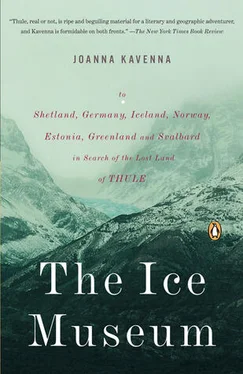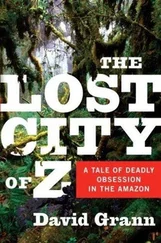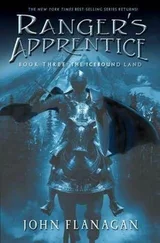The critics bayed, in print and in the learned clubs of international polar exploration. General Adolphus Washington Greely, Sir Francis Leopold McClintock, Sir Allen Young, all distinguished in their fields, were united in their fears that Nansen would perish. They predicted various deaths for the Norwegian: his ship would run aground on lands hidden in the ice around the Pole; he would cut off his escape route and lose his ship to the force of the ice. They conceded that his plan was audacious, it might just work, but the risks were too great. The finest of Victorian exploration briefed against the young Norwegian—as if the nineteenth-century figures in the National Portrait Gallery descended from their frames, to mutter condemnations.
The rotund hull of Fram signalled a new approach, which drifted where the Arctic current ran, making a strategy of impotence. It was a broad-hipped boat, with frame timbers made of choice Italian oak. The outside planking, now so scrubbed and sanctified, was an intricate barrier of three layers, the inner one made of oak three inches thick. Outside this, there was another oak layer, four inches thick, and outside this there was the ‘ice-skin of greenheart,’ wrote Nansen. The aim was to ensure that the ice could claw away all of the ice sheathing, and yet leave the hull untouched. The ‘Achilles’ heel’ of an ice ship, the rudder, was to be built so low down as to be invisible below the waterline, so if a floe collided forcefully with the stern it would shatter against the strong stern part and not hit the rudder itself. Fram was fitted out with everything they might need: a well-stocked library—protection against the boredom of the Arctic night—a self-registering aneroid barometer, a self-registering thermometer, a large theodolite, a spectroscope especially adapted for the Northern Lights, an electroscope for measuring the electricity in the air. Sledge dogs from Siberia whined below-decks.
Fram could carry coal for four months’ steaming at full speed, but Nansen imagined there would be little cause for steaming. It was the perfect ship to sit and wait in. With this precision, this attention to every detail he could find, Nansen proposed to travel into the unknown regions around the North Pole.
After roaming Fram for hours, I began to imagine that I had sailed in it, that I had felt the smash of the ice against its bow, had been thrown from my bunk by the pressure of the bergs. I came to a halt in the communal area, standing by the piano, imagining the festive occasions, the moments of release from the cold business of exploration, with someone pounding the piano while the crew sang. But, there was a small child tugging at the companion ladder, calling for her father, and my head was reeling from the dank below-decks air. Shaking the past from my heels, I clambered up to the deck and crossed the gangplank back to the present.
Fram had drifted perfectly, resisting the force of the ice, but she drifted insufficiently. The moving ice moved too far south, and at 84° N Nansen decided to leave the ship, and head for the Pole by ski and sledge. In mid-March 1895, Nansen set off with another member of his crew, Frederik Hjalmar Johansen, a lieutenant who had been so keen to come on Nansen’s ice expedition that he dropped into the only position available—the stoker. Fram , trapped in the ice, but defending herself against its clutches, was left in the care of Commander Otto Sverdrup, who had followed Nansen before on the ski-trip across Greenland. Now Sverdrup was left with the crew, looking nervously at the ice stacked around the ship. The first refractions of the sun against the ice were visible as Nansen set off; it would soon return to lurk low in the sky. Nansen and Johansen had sledges and dogs; they wore woollen clothes, camel-hair coats, socks made from sheep’s wool and human hair, knickerbockers, ‘what is called on board ship an anorak,’ wolf-skin gloves, snowshoes and felt hats. They carried a reindeer-skin double sleeping bag, little knowing they would be sleeping in it together for a year, a strong tent made of undressed silk, and a recent innovation in Arctic camping, a Primus stove from Sweden. They each took two double-barrelled guns.
Swift on their skis and extremely fit, Nansen and Johansen were forced to turn back, after only three weeks of struggling through the ice. ‘The ice grew worse and worse,’ Nansen wrote, ‘and we got no way. Ridge after ridge, and nothing but rubble to travel over. We made a start at two o’clock or so this morning, and kept at it as long as we could, lifting the sledges all the time; but it grew too bad at last. I went on a good way ahead on snowshoes, but saw no reasonable prospect of advance, and from the highest hummocks only the same kind of ice was to be seen. It was a veritable chaos of ice-blocks, stretching as far as the horizon. There is not much sense in keeping on longer; we are sacrificing valuable time and doing little.’ On 8 April 1895, Nansen decided to give up, and turned southwards. The ice, the barrier he had hoped to surmount by the careful construction of the perfectly passive ship, had defeated his active attempts to move across it. They turned away from the Pole, and moved painfully over the uneven ridges of ice, towards land. They got lost; they spent a winter holed up in a frozen hut, shooting bears to survive. They were bored, frightened at times, when they almost lost their guns in the water, or when a bear crashed towards the hut. After days and nights together, deprived of other company, they ran out of things to say, so they fantasized together about soft clothes, a Turkish bath, cakes, chocolate, bread and potatoes. By July 1896, Nansen was camped on an expanse of permafrosted land—he was not sure where he was. The clouds of mist that had obscured the land the previous day were beginning to lift, when Nansen heard the distant sound of dogs barking. ‘It seemed incredible, and yet—out of the shadowland of doubt, certainty was at last beginning to dawn,’ he wrote.
Certainty came in the embodied form of a Mr. Frederick Jackson, an Englishman, who was wandering around on Franz Josef Land, an island north-east of Svalbard. This was, Nansen discovered, where he had camped. The two men met. Jackson was a well-dressed Englishman in a checked suit and high rubber water boots, smelling strongly of soap, raising his hat to say ‘How do you do?’ Nansen was a man dyed black with oil and soot, with a long, shaggy beard, wearing foul-smelling rags and something roughly akin to a hat, but he extended a dirty hand, shaking Jackson’s recently scrubbed and perfumed one, soft to the touch. Their conversation was brief, confused at first by Jackson’s failure to recognize Nansen. Nansen recorded it in his notes:
Seizing the soot-encrusted hand again and shaking it still more vigorously, Jackson said, ‘I am very glad to see you!’
‘I’m immensely glad to see you,’ said Jackson.
‘Thank you, I also,’ replied Nansen.
‘Have you a ship here?’ asked Jackson.
‘No, my ship is not here,’ replied Nansen.
‘How many are there of you?’ asked Jackson.
‘I have one companion at the ice edge,’ replied Nansen.
And then Jackson suddenly stopped talking and looked the oil-stained
man in the face.
‘Aren’t you Nansen?’ he asked.
And Nansen answered, ‘Yes, I am.’
A well-washed Stanley to Nansen’s blubber-greased Living-stone, Jackson supplied a hut to sleep in, water to bathe in and letters from Norway, which he had taken in case of just such an unlikely meeting. Nansen and Johansen were swiftly released from the elements; their oil and soot encrustations were washed away. ‘The troglodyte has vanished,’ wrote Nansen, ‘and in his place sits a well-favoured, healthy-looking European citizen in a comfortable chair, puffing away at a short pipe or a cigar, and with a book before him.’ The dark heart of the Arctic night had been washed from their bodies, Nansen seemed to say; they were reclaimed by civilization. Nansen had tried to harness the power of nature to achieve his ends, but he was forced in the end to admit defeat. ‘Nature goes her age-old round impassively; summer changes into winter; spring vanishes away; autumn comes, and finds us still a chaotic whirl of daring projects and shattered hopes,’ he wrote. He had managed a distance of 86°13.6’ N, the furthest north so far reached by any explorer. He had spent three years of his life in the far north, leaving his wife, his child and his job. He had proved his theory of the drift of the ocean, he had returned without losing a man, but he had failed to reach the North Pole.
Читать дальше












